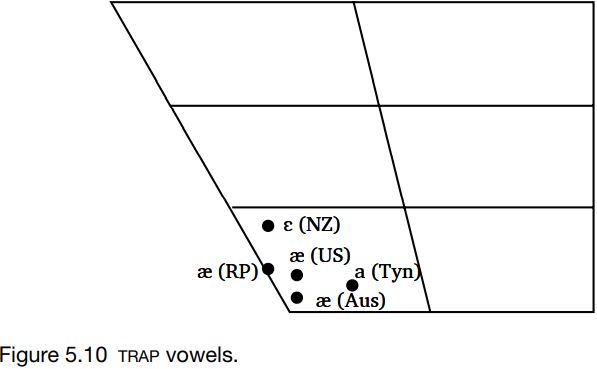


 Grammar
Grammar
 Tenses
Tenses
 Present
Present
 Past
Past
 Future
Future
 Parts Of Speech
Parts Of Speech
 Nouns
Nouns
 Verbs
Verbs
 Adverbs
Adverbs
 Adjectives
Adjectives
 Pronouns
Pronouns
 Pre Position
Pre Position
 Preposition by function
Preposition by function 
 Preposition by construction
Preposition by construction
 Conjunctions
Conjunctions
 Interjections
Interjections
 Grammar Rules
Grammar Rules
 Linguistics
Linguistics
 Semantics
Semantics
 Pragmatics
Pragmatics
 Reading Comprehension
Reading Comprehension
 Teaching Methods
Teaching Methods|
Read More
Date: 14-6-2022
Date: 2023-08-15
Date: 25-6-2022
|
The trap vowel varies along the front–back and open–close dimensions and is variously transcribed as [a æ ε]. What cannot be shown from the vowel quadrilateral so easily is the differences in duration. In the USA, this vowel is regularly long in duration in comparison with other varieties of English.
The symbol [æ] stands for three different qualities: most open in Australia, closest and frontest in RP and most central in American English. If we wanted to distinguish these qualities while using the same symbol, we could elaborate the transcriptions with diacritics. ‘Closer’ and ‘more open’ are handled with  respectively; ‘fronter’ and ‘backer’ with [+], [-]. Vowels shifted to the centre of the quadrilateral can be marked with
respectively; ‘fronter’ and ‘backer’ with [+], [-]. Vowels shifted to the centre of the quadrilateral can be marked with  . So we could write
. So we could write  for RP,
for RP,  for Australian and [æ] for American. This transcription style is comparative. Another strategy would be to refer the qualities directly to CVs, in which case we might transcribe RP as
for Australian and [æ] for American. This transcription style is comparative. Another strategy would be to refer the qualities directly to CVs, in which case we might transcribe RP as  (i.e. more open than CV3, [ε]), Australian as [a] (close to CV4) and American as [ä] (more centralized than CV4, [a]). This transcription style is more impressionistic. It is precisely because of the problems of deciding which symbol to use that phoneticians use graphs to plot where vowels lie, even if this is just an approximation.
(i.e. more open than CV3, [ε]), Australian as [a] (close to CV4) and American as [ä] (more centralized than CV4, [a]). This transcription style is more impressionistic. It is precisely because of the problems of deciding which symbol to use that phoneticians use graphs to plot where vowels lie, even if this is just an approximation.

|
|
|
|
دراسة: حفنة من الجوز يوميا تحميك من سرطان القولون
|
|
|
|
|
|
|
تنشيط أول مفاعل ملح منصهر يستعمل الثوريوم في العالم.. سباق "الأرنب والسلحفاة"
|
|
|
|
|
|
|
المجمع العلمي يقيم دورة تطويرية عن أساليب التدريس ويختتم أخرى تخص أحكام التلاوة
|
|
|